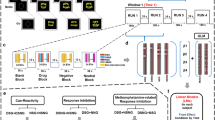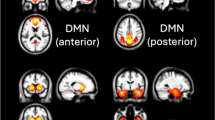Abstract
Qualitative poor decision-making and associated altered neuronal activation patterns have been described for the users of several drugs, amongst others for stimulants like amphetamine and MDMA. Deficits in decision-making might be caused by an augmented attraction to short-term rewarding properties despite negative long-term consequences, leading to rigid stimulus–response patterns. In the present imaging study, we investigated decision-making and associated neuronal activation in three groups differing in their exposure to amphetamine and MDMA. An established paradigm on risky choices was used to evaluate decision-making performance and corresponding functional magnet resonance imaging (fMRI) activation. Subjects could choose between a low-risk control gamble and an experimental gamble, which always differed in the probability of winning or losing, as well as the magnitudes of monetary gain or loss. Experienced users (EU), users with low exposure to stimulants and drug-naive controls, did not differ from each other in behavioral performance. In accordance with our hypotheses, the anticipation of reward led to an activation of primarily the frontal cortex and the striatum in low-exposure users and drug-naive controls. In contrast, frontal and parietal activation was observed in all groups when the actual outcome of an experimental gamble was presented. EU displayed more activation compared to both control groups when there was a high probability of winning. The study at hand supports the hypothesis that neuronal activation patterns might even differ between drug users and healthy controls when no behavioral deficits are apparent. In EU, the probability of the occurrence of an event has more influence on neuronal activation than on the actual magnitude of reinforcing properties of this event.
Similar content being viewed by others
Log in or create a free account to read this content
Gain free access to this article, as well as selected content from this journal and more on nature.com
or
References
Aron JL, Paulus MP (2007). Location, location: using functional magnetic resonance imaging to pinpoint brain differences relevant to stimulant use. Addiction 102 (Suppl 1): 33–43.
Becker B, Wagner D, Koester P, Bender K, Kabbasch C, Gouzoulis-Mayfrank E et al (2012). Memory-related hippocampal functioning in ecstasy and amphetamine users: a prospective fMRI study. Psychopharmacology (Berl) 225: 923–934.
Bedi G, Phan KL, Angstadt M, de Wit H (2009). Effects of MDMA on sociability and neural response to social threat and social reward. Psychopharmacology (Berl) 207: 73–83.
Bolla KI, Eldreth DA, London ED, Kiehl KA, Mouratidis M, Contoreggi C et al (2003). Orbitofrontal cortex dysfunction in abstinent cocaine abusers performing a decision-making task. Neuroimage 19: 1085–1094.
Bolla KI, Eldreth DA, Matochik JA, Cadet JL (2005). Neural substrates of faulty decision-making in abstinent marijuana users. Neuroimage 26: 480–492.
Cowan RL, Lyoo IK, Sung SM, Ahn KH, Kim MJ, Hwang J et al (2003). Reduced cortical gray matter density in human MDMA (Ecstasy) users: a voxel-based morphometry study. Drug Alcohol Depend 72: 225–235.
Cservenka A, Nagel BJ (2012). Risky decision-making: an FMRI study of youth at high risk for alcoholism. Alcohol Clin Exp Res 36: 604–615.
Daumann J, Fischermann T, Heekeren K, Henke K, Thron A, Gouzoulis-Mayfrank E (2005). Memory-related hippocampal dysfunction in poly-drug ecstasy (3,4-methylenedioxymethamphetamine) users. Psychopharmacology (Berl) 180: 607–611.
Daumann J, Koester P, Becker B, Wagner D, Imperati D, Gouzoulis-Mayfrank E et al (2011). Medial prefrontal gray matter volume reductions in users of amphetamine-type stimulants revealed by combined tract-based spatial statistics and voxel-based morphometry. Neuroimage 54: 794–801.
De Win MM, Jager G, Booij J, Reneman L, Schilt T, Lavini C et al (2008). Sustained effects of ecstasy on the human brain: a prospective neuroimaging study in novel users. Brain 131 (Pt 11): 2936–2945.
Ersche KD, Fletcher PC, Lewis SJ, Clark L, Stocks-Gee G, London M et al (2005). Abnormal frontal activations related to decision-making in current and former amphetamine and opiate dependent individuals. Psychopharmacology (Berl) 180: 612–623.
Figee M, Vink M, de Geus F, Vulink N, Veltman DJ, Westenberg H et al (2011). Dysfunctional reward circuitry in obsessive-compulsive disorder. Biol Psychiatry 69: 867–874.
Gallinat J, Meisenzahl E, Jacobsen LK, Kalus P, Bierbrauer J, Kienast T et al (2006). Smoking and structural brain deficits: a volumetric MR investigation. Eur J Neurosci 24: 1744–1750.
Hanson KL, Luciana M, Sullwold K (2008). Reward-related decision-making deficits and elevated impulsivity among MDMA and other drug users. Drug Alcohol Depend 96: 99–110.
Hutton C, Draganski B, Ashburner J, Weiskopf N (2009). A comparison between voxel-based cortical thickness and voxel-based morphometry in normal aging. Neuroimage 48: 371–380.
Jenkinson M, Bannister P, Brady M, Smith S (2002). Improved optimization for the robust and accurate linear registration and motion correction of brain images. Neuroimage 17: 825–841.
Jenkinson M, Smith S (2001). A global optimisation method for robust affine registration of brain images. Med Image Anal 5: 143–156.
Kalivas PW, Volkow ND (2005). The neural basis of addiction: a pathology of motivation and choice. Am J Psychiatry 162: 1403–1413.
Kish SJ, Lerch J, Furukawa Y, Tong J et al (2010). Decreased cerebral cortical serotonin transporter binding in ecstasy users: a positron emission tomography/((11)C)DASB and structural brain imaging study. Brain 133 (Pt 6): 1779–1797.
Knutson B, Adams CM, Fong GW, Hommer D (2001). Anticipation of increasing monetary reward selectively recruits nucleus accumbens. J Neurosci 21: RC159.
Koester P, Tittgemeyer M, Wagner D, Becker B, Gouzoulis-Mayfrank E, Daumann J (2012). Cortical thinning in amphetamine-type stimulant users. Neuroscience 221: 182–192.
Koob GF, Simon EJ (2009). The neurobiology of addiction: where we have been and where we are going. J Drug Issues 39: 115–132.
Kuhn S, Schubert F, Gallinat J (2010). Reduced thickness of medial orbitofrontal cortex in smokers. Biol Psychiatry 68: 1061–1065.
Lawyer G, Bjerkan PS, Hammarberg A, Jayaram-Lindstrom N, Franck J, Agartz I (2010). Amphetamine dependence and co-morbid alcohol abuse: associations to brain cortical thickness. BMC Pharmacol 10: 5.
Mechtcheriakov S, Brenneis C, Egger K, Koppelstaetter F, Schocke M, Marksteiner J (2007). A widespread distinct pattern of cerebral atrophy in patients with alcohol addiction revealed by voxel-based morphometry. J Neurol Neurosurg Psychiatry 78: 610–614.
Moeller FG, Steinberg JL, Lane SD, Buzby M, Swann AC, Hasan KM et al (2007). Diffusion tensor imaging in MDMA users and controls: association with decision making. Am J Drug Alcohol Abuse 33: 777–789.
Murphy PN, Bruno R, Ryland I, Wareing M, Fisk JE, Montgomery C et al (2012). The effects of ecstasy' (MDMA) on visuospatial memory performance: findings from a systematic review with meta-analyses. Hum Psychopharmacol 27: 113–138.
Paulus MP, Hozack N, Frank L, Brown GG, Schuckit MA (2003). Decision making by methamphetamine-dependent subjects is associated with error-rate-independent decrease in prefrontal and parietal activation. Biol Psychiatry 53: 65–74.
Paulus MP, Tapert SF, Schuckit MA (2005). Neural activation patterns of methamphetamine-dependent subjects during decision making predict relapse. Arch Gen Psychiatry 62: 761–768.
Quednow BB, Kuhn KU, Hoppe C, Westheide J, Maier W, Daum I et al (2007). Elevated impulsivity and impaired decision-making cognition in heavy users of MDMA (‘Ecstasy’). Psychopharmacology (Berl) 189: 517–530.
Roberts GM, Garavan H (2010). Evidence of increased activation underlying cognitive control in ecstasy and cannabis users. Neuroimage 52: 429–435.
Roesch MR, Olson CR (2004). Neuronal activity related to reward value and motivation in primate frontal cortex. Science 304: 307–310.
Rogers RD, Everitt BJ, Baldacchino A, Blackshaw AJ, Swainson R, Wynne K et al (1999). Dissociable deficits in the decision-making cognition of chronic amphetamine abusers, opiate abusers, patients with focal damage to prefrontal cortex, and tryptophan-depleted normal volunteers: evidence for monoaminergic mechanisms. Neuropsychopharmacology 20: 322–339.
Rogers RD, Ramnani N, Mackay C, Wilson JL, Jezzard P, Carter CS et al (2004). Distinct portions of anterior cingulate cortex and medial prefrontal cortex are activated by reward processing in separable phases of decision-making cognition. Biol Psychiatry 55: 594–602.
Rogers RD, Tunbridge EM, Bhagwagar Z, Drevets WC, Jezzard P, Carter CS et al (2003). Tryptophan depletion alters the decision-making of healthy volunteers through altered processing of reward cues. Neuropsychopharmacology 28: 153–162.
Rolls ET (2004). The functions of the orbitofrontal cortex. Brain Cogn 55: 11–29.
Schilt T, Goudriaan AE, Koeter MW, van den Brink W, Schmand B (2009). Decision making as a predictor of first ecstasy use: a prospective study. Psychopharmacology (Berl) 203: 519–527.
Schoenbaum G, Roesch MR, Stalnaker TA (2006). Orbitofrontal cortex, decision-making and drug addiction. Trends Neurosci 29: 116–124.
Schoenbaum G, Shaham Y (2008). The role of orbitofrontal cortex in drug addiction: a review of preclinical studies. Biol Psychiatry 63: 256–262.
Smerdon MJ, Francis AJ (2011). Reward sensitivity and outcome expectancies as predictors of ecstasy use in young adults. Addict Behav 36: 1337–1340.
Smith SM (2002). Fast robust automated brain extraction. Hum Brain Mapp 17: 143–155.
Smith SM, Jenkinson M, Woolrich MW, Beckmann CF, Behrens TE, Johansen-Berg H et al (2004). Advances in functional and structural MR image analysis and implementation as FSL. Neuroimage 23 (Suppl 1): S208–S219.
Studer B, Apergis-Schoute AM, Robbins TW, Clark L (2012). What are the odds? The neural correlates of active choice during gambling. Front Neurosci 6: 46.
Tobler PN, Christopoulos GI, O’Doherty JP, Dolan RJ, Schultz W (2009). Risk-dependent reward value signal in human prefrontal cortex. Proc Natl Acad Sci USA 106: 7185–7190.
UNODC (2011). 2011 Global ATS Assessment. United Nations Publicationhttp://www.unodc.org/documents/ATS/ATS_Global_Assessment_2011.pdf.
van Hell HH, Vink M, Ossewaarde L, Jager G, Kahn RS, Ramsey NF (2010). Chronic effects of cannabis use on the human reward system: an fMRI study. Eur Neuropsychopharmacol 20: 153–163.
Volkow ND, Fowler JS, Wang GJ, Baler R, Telang F (2009). Imaging dopamine’s role in drug abuse and addiction. Neuropharmacology 56 (Suppl 1): 3–8.
Wagner D, Becker B, Koester P, Gouzoulis-Mayfrank E, Daumann J (2012). A prospective study of learning, memory, and executive function in new MDMA users. Addiction 108: 136–145.
Woolrich MW, Jbabdi S, Patenaude B, Chappell M, Makni S, Behrens T et al (2009). Bayesian analysis of neuroimaging data in FSL. Neuroimage 45 (Suppl 1): S173–S186.
Woolrich MW, Ripley BD, Brady M, Smith SM (2001). Temporal autocorrelation in univariate linear modeling of FMRI data. Neuroimage 14: 1370–1386.
Worsley KJ, Evans AC, Marrett S, Neelin P (1992). A three-dimensional statistical analysis for CBF activation studies in human brain. J Cereb Blood Flow Metab 12: 900–918.
Acknowledgements
This study was supported in part by a grant to E Gouzoulis-Mayfrank and J Daumann from the Deutsche Forschungsgemeinschaft (DFG GO 717/6-1/2). We additionally would like to thank Hendrik Koester for the production of the images. Marc Tittgemeyer is supported by the German Research Foundation in the Clinical Research Group 219.
Author information
Authors and Affiliations
Corresponding author
Ethics declarations
Competing interests
The authors declare no conflict of interest.
Rights and permissions
About this article
Cite this article
Koester, P., Volz, K., Tittgemeyer, M. et al. Decision-making in Polydrug Amphetamine-type Stimulant Users: an fMRI Study. Neuropsychopharmacol 38, 1377–1386 (2013). https://doi.org/10.1038/npp.2013.43
Received:
Revised:
Accepted:
Published:
Issue date:
DOI: https://doi.org/10.1038/npp.2013.43
Keywords
This article is cited by
-
“The Bad Things that Happened Are Kind of Good Things”: Exploring Gambling Among Residents of a Transitional Housing Service
International Journal of Mental Health and Addiction (2022)
-
Basal ganglia lateralization in different types of reward
Brain Imaging and Behavior (2020)



